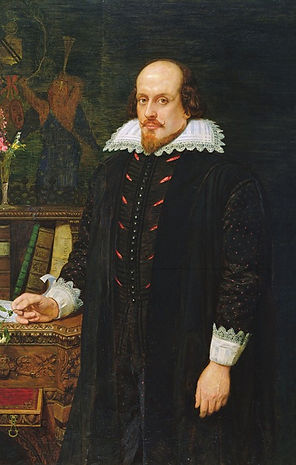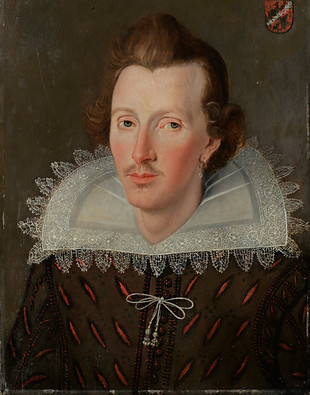

history
Where did the portrait come from?
Peter Wadlow tells us that the portrait came from a large house in the Banbury area that was being renovated in the late 1960s. Peter's description of the house indicates that the painting probably came from Great Tew manor. At that time, the house had been inherited by Major Eustace Robb but was in a bad condition so Robb embarked on a massive renovation project.

Great Tew manor house
He started by clearing out anything that could be sold to raise funds and this included many paintings. An example of the types of work that were in the house came to light after the Major’s death. Amongst the many artworks was a drawing by Michelangelo. Having remained hidden in the house for centuries the work sold at auction by Christies for £4.1m
Shakespeare in disguise
Why would anyone want to disguise a portrait of William Shakespeare?
The overpaint on the Wadlow portrait points to attempts to try to disguise the identity of the subject whatever his identity might be.
16th and 17th century England was torn apart by religious intolerance. There is evidence that points to Shakespeare’s family being Catholics, his father John was often absent from his local protestant church and was fined as a result. During Cromwell’s reign when the theatres were closed having a portrait of a playwright on the wall might have got its owner into trouble and lead to the painting being destroyed as often happened. So if you wanted to keep it on display one way to do that would be to hide the sitter’s identity.

Coat of arms revealed by x-ray under overpainting at left side of portrait

Coat of arms revealed by x-ray. Top right under later added fake coat of arms.
There were ways to disguise a painting and let other Catholics know that you hadn’t turned away from the Pope. It is probable that one such clue might exist in the collar of the Wadlow portrait. It is made up of intricate lace stars with four points. However one of them has six points which is similar to “Mary’s star” an important Catholic symbol. The painting also contains examples of the Quincunx a five dot pattern used in secret Catholic meeting houses in the Midlands which depicts the 'Five wounds of Christ'. They can be seen on the doublet.

Area that might contain signature on the collar. The star at the right has six points all the others have only four. Is this a star of Mary, a catholic symbol?

Did the wadlow portrait influence this portrait of shakespeare?

We recently came across this interesting portrait of Shakespeare painted by Ford Madox Brown in 1849. In his diary he says he painted it because there was no agreement about what Shakespeare really looked like. So he created it as an amalgamation of several other portraits of Shakespeare, with the face based mainly on the memorial to Shakespeare in St Michael's church Stratford upon Avon.
In the portrait Shakespeare is shown surrounded by books and objects that inspired his work. But it isn't the face or the background objects that are interesting when we think about the Wadlow portrait, it is the clothes and hair.

The collar of the 1849 portrait is not found on any known portrait of Shakespeare at that time. Also the slashed tunic revealing red cloth beneath it is not seen on any known portrait of Shakespeare, yet both are strikingly similar to the Wadlow portrait. The colour of the hair is also the same as the Wadlow. A description of Shakespeare's hair on the original memorial bust in Stratford (before it was repainted) describes it as auburn. The Chandos and the Cobbe both have dark hair. The curls above the ear are also very similar.


The sketch of Shakespeare by Ford Madox Brown drawn a few years later seen below, shows a pattern in between the red slashes. They are similar to the pattern between the slashes on the tunic of the Wadlow portrait. The row of buttons on the tunic are also strikingly similar.


In this other portrait of Shakespeare by Ford Madox Brown shown below, there is a striking similarity between the fake overpainted coat of arms on the top right of the Wadlow portrait and Shakespeare's coat of arms at the top left of the Ford Madox Brown portrait. Traditionally mustard coloured, here Shakespeare's coat of arms is mainly red, as is the fake coat of arms on the Wadlow. Both also have a diagonal.

With so many similarities between Ford Madox Brown's portraits of Shakespeare and the Wadlow, we are continuing our research into this portrait to see if Ford Madox Brown was aware of the Wadlow portrait and used it as inspiration for his portraits.